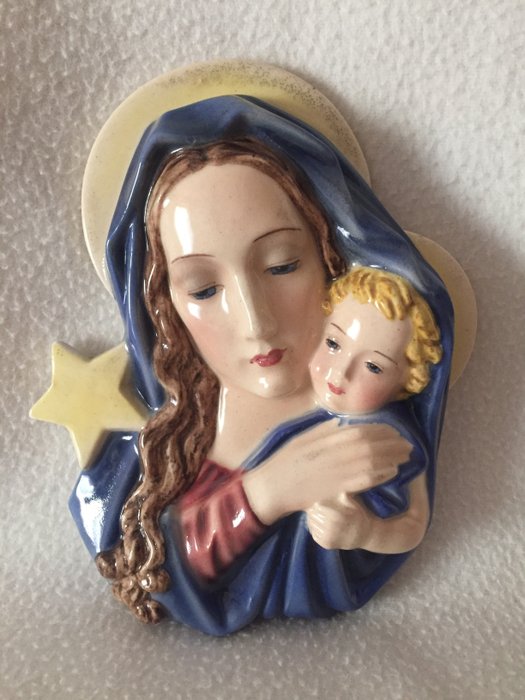Nr 16273381

Keramos Wien Madonna (Virgin Mary & child) Art Deco Austria porcelain plaque
Nr 16273381

Keramos Wien Madonna (Virgin Mary & child) Art Deco Austria porcelain plaque
Stunning deco Keramos porcelain Madonna and child plaque (or wall mask) from Wien with incredible detail and design.
Attributed to Klieber (he made other religious figures in the 1920s in this style) or to Stefan Dakon (that worked in the 30s for Keramos). Both ceramists designed for Goldsheider and Keramos.
Plaque has on its back has the WIEN KERAMOS Austria Mark STAMP, and it has impressed the number 1640 as well as 1 and 42, so those are supposed to be the serial numbers and registration numbers, that factory made this way.
Dimensions in cm are 15 high x 12'5 wide x 3 deep.
Weighs 200 g approximately.
Condition: The piece is absolutely in excellent condition. No chips, cracks, crazing, it has not been restored, or has other damage. There is no chip, crack, and has not been restored.
KERAMOS HISTORY: WIENER KUNST-KERAMIK und PORZELLANMANUFAKTUR AG, was a Viennese art pottery ceramic and porcelain manufacture founded 1910 by several disabled ex-service man, supportived financially by the State Austria and later converted to a public limited company lead by the Director Otto Köller and Rudof Wolf und Heinrich Wolf. The company was located in the famous Hofburg building, Scharze Adlerstiege; the manufacture was located in 10th district of Vienna, Schleiergasse 17. In 1932 the company engaged more than 50 employees and they took over a large assortment of models by the sculptor Eduard Klablena and several designs of the Wiener Werkstaette / Wiener Werkstätte.
The company manufactured luxury items, Faiences, Majolica (figurines, animal sculptures, lamps, vases and trinket boxes) and was represented the the Art Exhibition in Paris in 1925 (silver medal prize).
Wilhelm Thomasch created pieces in the 1920's in Goldscheider with artists such as Dakon, Knörlein, Larroux, Lavergne, Lorenzl, Podany, Schramm, including the now coveted collector's items of wall masks, dancers, animals, children, etc., until in 1926 he independently accquired an existing pottery in Sierndorf, Lower Austria.
After the end of the 2nd World War Thomasch expanded in 1950. With up to 60 employees Thomasch was one of the largest employers in the region.
Wilhelm died in 1965. His wife Anna Thomasch, her son Herwig and brother Franz Wöginger led the operation until 1970 . With the retirement of Mrs. Thomasch the business was closed.
The site has images of pieces similar to my bowl although they are handled baskets, the glazes and the floral modeling are almost identical.
Packing and shipping is made on the best and fast service, superb well packed with tracking number. It will be shipped internationally via Courier or registered mail.
Ten przedmiot został zaprezentowany w
Jak kupować w serwisie Catawiki
1. Odkryj coś wyjątkowego
2. Złóż najwyższą ofertę
3. Dokonaj bezpiecznej płatności
